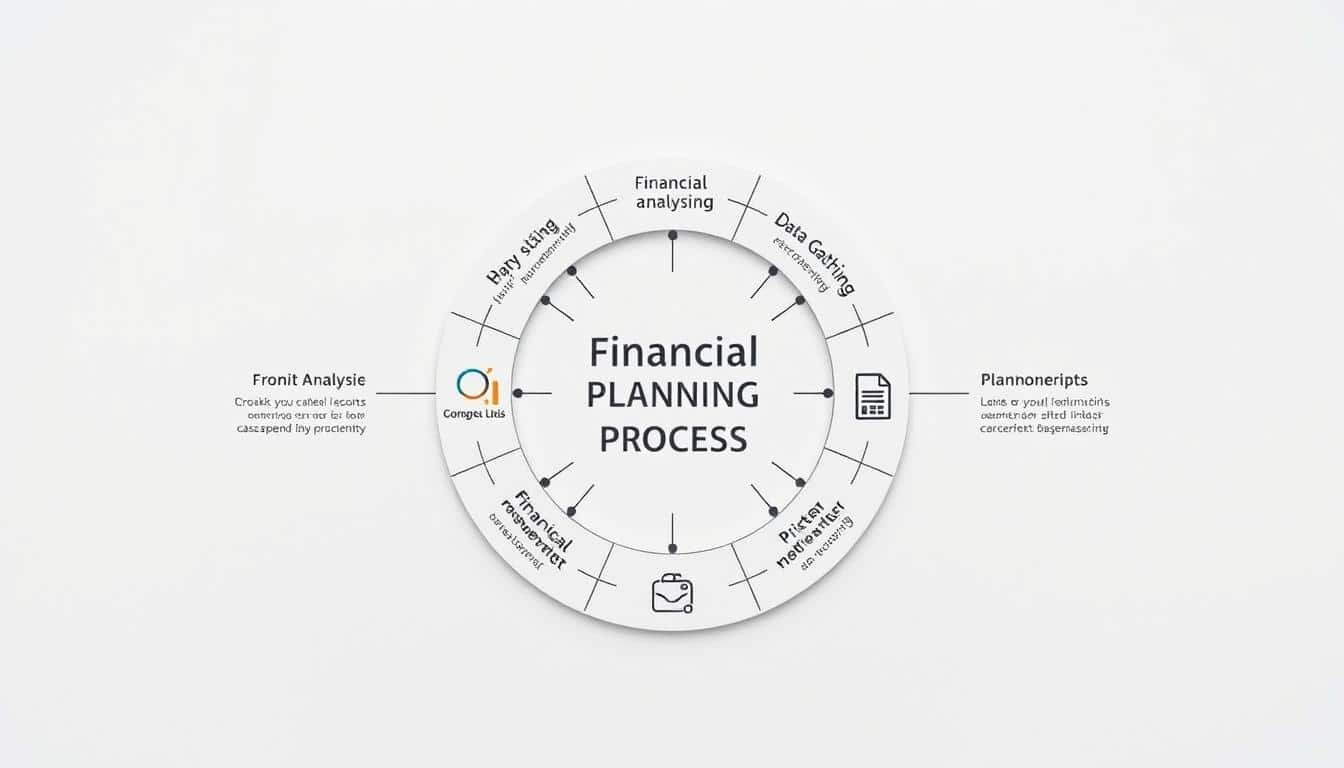Your Guide to the Financial Planning Process
Financial planning isn’t just for the rich. The Millers, who make $230,000 a year, use it to save $12,600 each year. They’ve grown their net worth to $290,000. This guide will show you how to plan your finances to reach your goals, like saving for retirement or college.
The first step in wealth management is to know your income, savings, and debt. The Millers keep track of their $34,500 in annual cash flow to reach their $150,000 goal for a lake cabin. This guide will help you manage your money better, whether you’re budgeting or investing.
Key Takeaways
- Financial planning is for everyone, not just the wealthy.
- It involves assessing your cash flow, setting goals, and choosing how to save or invest.
- Managing your finances means balancing your expenses, like the Millers’ $15,000 in fixed costs and $48,000 in lifestyle choices.
- A tailored plan covers both immediate needs and long-term dreams, like college or retirement.
- Regularly reviewing your plan helps it stay on track with life’s changes, like the Millers’ increased 401(k) contributions after paying off loans.
What is Financial Planning?
Financial planning is like a roadmap for your money. It helps you reach your personal and financial goals. It’s not just for the wealthy—it’s for anyone wanting stability and less stress.
Whether you’re saving for college or starting a business, financial planning fits your needs. It ensures every decision matches your priorities.
Definition and Importance
Financial planning starts with knowing what’s important to you. It’s about tracking your income, cutting spending, and growing your savings. It also prepares you for emergencies, like medical bills or losing your job.
A wealth management process goes further, focusing on long-term growth. It involves investments and tax strategies. Regular check-ins keep your plan up-to-date as your life changes.
Certified Financial Planner professionals can help keep you on track. They make sure your goals stay achievable.
Key Components of Financial Planning
A solid plan has five key parts: estate planning, retirement strategies, risk management, tax optimization, and investment growth. Managing your cash flow is also crucial. It ensures you don’t spend too much.
Reducing debt and smart budgeting are also important. For example, saving 20% of your income and diversifying investments can lower risk. The financial planning process balances these elements, adjusting as you reach milestones.
Regular updates, like changing insurance policies or tax filings, keep your strategy current. This ensures it stays aligned with your life’s changes.
The Steps in the Financial Planning Process
Mastering the financial planning process starts with clear financial planning steps. Each step builds a strong foundation for the future. The wealth management process focuses on your unique financial situation and goals. Let’s look at how to turn uncertainty into clear steps.
Assessment of Current Financial Situation
Start by understanding your financial situation. List your income, track your expenses, and compare your assets to debts. High-interest debt or not enough savings for emergencies show areas to focus on. This step is crucial for making future decisions.
Setting Financial Goals
Next, set both short-term and long-term goals. Short-term goals might be paying off debt, while long-term goals could be retirement. Make sure your goals are Specific, Measurable, Achievable, Relevant, and Time-bound. Regularly check if your goals still match your life.
Developing a Financial Plan
Based on your assessment and goals, create a plan. Experts like fiduciary advisors can help make a plan that fits you. They offer a 100% money-back guarantee, showing they’re committed to your success.
Implementation of the Plan
Now, it’s time to take action. Automate your savings, adjust your spending, and check your progress monthly. Be ready to make changes as your life changes. The financial planning process works best with ongoing adjustments.
Understanding Financial Goals
Effective financial planning steps start with clear financial goal setting. Goals are like maps, guiding us from saving for emergencies to planning for retirement. Begin by sorting out what you need now from what you want later. This way, every dollar you spend aligns with your priorities.
Short-Term vs. Long-Term Goals
Short-term goals (1–3 years) cover urgent needs like building an emergency fund or paying off credit card debt. Long-term goals (5+ years) are about saving for retirement or college. Use the 50/30/20 rule to budget: 50% for needs, 30% for wants, and 20% for savings or debt.
| Type | Timeframe | Examples |
|---|---|---|
| Short-Term | 1-3 years | Emergency fund, debt payoff |
| Long-Term | 5+ years | Retirement savings, education funds |
SMART Goal Setting for Finances
SMART goals (Specific, Measurable, Achievable, Relevant, Time-bound) make vague ideas into real plans. For instance, a SMART retirement goal could be: “Save $1,000 monthly in a 401(k) by increasing contributions to 10% of income by 2025.” Check your progress every year to keep on track.
| Component | Description |
|---|---|
| Specific | “Save $500 emergency fund by June 2024” |
| Measurable | Track monthly deposits of $100 |
| Achievable | Adjust budget to cut discretionary spending |
| Relevant | Aligns with family priorities like education |
| Time-bound | Target debt-free date by December 2025 |
Life changes, like a job promotion or having a family, should guide your financial plans. Financial advisors suggest reviewing your goals every year to stay on track.
Budgeting Basics
Learning budgeting and expense tracking is key to financial planning steps. First, list all your income and fixed costs like rent and loans. Use the 50/30/20 rule: 50% for needs, 30% for wants, and 20% for savings.
If your needs are more than 50%, adjust to 60/30/10. This helps manage your finances better.
Creating a Monthly Budget
Start with your net income and subtract fixed costs. Save for emergencies first, aiming for $500, then 3–6 months of expenses. Set aside 10–15% of your income for retirement.
Review your budget every quarter. This helps adjust to changes like raises or unexpected expenses.
Tracking Expenses Effectively
Use cash flow tracking to find where you spend too much. Remember to save for irregular expenses like car repairs. Apps like Mint or YNAB can help automate this.
Spreadsheets offer more customization. Regular checks keep you on track with your financial goals.
Tools and Apps for Budgeting
Compare tools using this table:
| Tool/App | Features | Cost |
|---|---|---|
| Mint | Auto-categorizes transactions, alerts | Free |
| YNAB | Goal-based budgeting, zero-based tracking | $14.99/month |
| Excel | Customizable templates, no subscription | Free |
Include high-interest debt repayment in your budget. If it takes over five years, look into relief options. Regular tracking helps build habits for long-term wealth.
Investment Planning
Creating an investment strategy is key to financial planning. It involves matching your goals with the right investments. Joe helped the Millers figure out their risk management by looking at their risk tolerance.
Choosing the Right Investments
Investors can choose from many options like stocks, bonds, real estate, and ETFs. Vanguard ETF Shares are like stocks but offer a mix of assets. But, buying them through brokers can cost money.
Yieldstreet offers private investments starting at $10,000. This is much lower than the usual $500,000+ needed for traditional investments.
Risk Tolerance in Action
Risk tolerance has three parts: how much risk you’re willing to take, your financial health, and what you think about the market. In 2020, art investments went up 15.1% while stocks went up and down. This shows how different assets can protect your money during tough times.
Vanguard’s risk questionnaires help figure out your risk level.
Building a Diversified Portfolio
Most portfolios are 60% stocks and 40% bonds. But, modern advice suggests adding more alternatives. Private-market investments did better than stocks in 2008 and 2018.
Here’s a comparison of different assets:
| Asset Class | Risk Level | Historic Returns |
|---|---|---|
| Stocks | High | Long-term growth |
| Bonds | Moderate | Steady income |
| Alternatives | Varied | 10–15% avg annual gains |
No strategy can promise profits. Taxes and market changes mean you need to keep adjusting. Working with planners like Vanguard Advisers helps your plan grow with you.
A good plan helps you stay calm during market ups and downs. It keeps you focused on your long-term goals.
Retirement Planning
Planning for retirement is a key part of the financial planning process that requires careful financial goal setting. Starting early is crucial. It helps grow your savings through compound interest.
Importance of Early Retirement Planning
Starting to save for retirement early is vital. Saving $5,000 a year from age 30 at 7% growth can grow to nearly $450,000 by 65. But, if you wait until 45, you’ll only have $148,000.
Early planning also helps you adjust to market changes. It lets you take advantage of employer matches in plans like 401(k)s.
Retirement Accounts: 401(k), IRA, Roth IRA
Choosing the right account depends on tax benefits and contribution limits. Here’s a comparison of popular options:
| Account Type | Contribution Limits (2025) | Tax Benefits | Withdrawal Rules |
|---|---|---|---|
| 401(k) | $23,000 (with catch-up) | Pre-tax contributions, tax-deferred growth | 10% penalty before 59½ |
| Traditional IRA | $7,000 | Tax-deductible contributions | Taxes on withdrawals after 59½ |
| Roth IRA | $7,000 | Tax-free withdrawals after age 59½ and 5-year holding period | No required minimum distributions |
Estimating Future Retirement Needs
Experts say you need 10–12 times your final salary for expenses. Consider:
– 70%–85% of your pre-retirement income (excluding Social Security’s 40% baseline)
– $300,000 average healthcare costs
– Delaying Social Security until 70 boosts benefits 8% annually past full retirement age
Use online calculators or consult planners. The 2025 catch-up contributions for those 60–63 allow $34,750 in 401(k) contributions. Start today to avoid joining the 40% of Americans who haven’t calculated their retirement needs.
Insurance Planning
Insurance is key in risk management in financial planning. It protects you from unexpected events that could harm your financial planning process. A good insurance plan keeps your family and assets safe during life’s surprises.
Types of Insurance to Consider
Life, health, disability, and property insurance are the basics. Dan and Martha’s story highlights the importance of each. Auto, renters, or homeowners policies are also crucial.
Long-term care insurance is vital as you get older. About 70% of seniors need this care. For the wealthy, life insurance trusts can help avoid estate taxes.
Importance of Life and Health Insurance
Life insurance pays for funeral costs (about $10,000) and replaces lost income. Without it, 40% of households might struggle financially after a family member dies. Health insurance helps avoid medical debt, which causes 62% of U.S. bankruptcies.
Disability insurance covers income if you can’t work. 25% of 20-year-olds will face this before they retire. Check your policies every year to keep up with life changes.
Insurance should grow with your needs. This ensures you’re always protected.
Tax Planning Strategies
Tax planning is a crucial part of financial planning. It helps you pay only what you owe and meets your long-term goals. For example, Dan and Martha (the Millers) in the 24% tax bracket can optimize their strategy by adjusting contributions to tax-advantaged accounts. Let’s explore how.
Understanding Tax Brackets
Marginal tax rates apply only to income within specific brackets. The Millers’ 24% rate means only their highest dollar earns that rate. Effective rates average lower. Income sources matter too: investment gains may face lower capital gains rates.
For instance, a single earner with $100,000 income and $10,000 in long-term gains faces a 15% tax on those gains in 2024. Capital losses can offset gains, reducing liability. The IRS allows deducting up to $3,000 in losses annually, with excess losses carried forward.
Tax-Efficient Investment Strategies
Maximizing tax-advantaged accounts like IRAs and 401(k)s reduces taxable income. In 2024, a single filer can contribute up to $7,000 to a traditional IRA. A 401(k) allows $23,000, lowering AGI.
Tax-loss harvesting lets investors offset gains taxes by selling losing investments. Pairing these steps with estate planning ensures compliance and growth. Tax planning isn’t a once-a-year task—it’s a year-round strategy to balance savings and tax efficiency.
Estate Planning Essentials
Estate planning is not just for the rich. It’s a vital part of financial planning that protects your family and assets. Sadly, over 70% of Americans don’t have a will. Without one, your assets could go to the state, not your loved ones.
What is Estate Planning?
Estate planning makes sure your assets go to the right people after you pass away. It involves making a will, setting up trusts, and choosing beneficiaries. A will tells who gets what and who will take care of your kids if you can’t.
Over 60% of parents without a plan risk the court deciding for them. It’s important to review these documents every few years or after big life changes.
Creating a Will and Trust
| Document | Purpose | When to Use |
|---|---|---|
| Will | Directs asset distribution and names guardians | Basic estate needs, under $1M assets |
| Revocable Living Trust | Avoids probate; manages assets during incapacity | High asset values or complex ownership |
| Irrevocable Trust | Reduces estate taxes; protects assets from creditors | Large estates or tax-sensitive situations |
Trusts offer more flexibility. The Millers’ $290,000 net worth could benefit from a revocable trust. This could avoid probate delays and protect their savings and lake cabin goal.
Importance of Beneficiary Designations
Beneficiary forms take precedence over wills for accounts like 401(k)s. Updating these ensures your retirement funds and insurance go to the right people. Only 38% of adults update their documents yearly, risking outdated choices.
The Millers’ life insurance might not reflect their current family situation. Regular estate plan reviews are crucial. Financial planners suggest updates every 3–5 years. Even small steps, like updating beneficiaries, can prevent future confusion.
Working with a Financial Planner
Finding the right financial planner can change your financial path. Martha and Dan Miller teamed up with Joe, a Certified Financial Planner®. Together, they set a financial planning process to save $150k for a lake cabin. First, check if the planner is certified and if they work on a fee-only basis to avoid conflicts.

How to Choose a Financial Planner
Discuss their financial planning process and wealth management process. Joe’s firm uses software to check the Millers’ $290k net worth for unbiased advice. It’s important to know how they charge, their experience with clients like you, and how they handle big changes like college costs.
Questions to Ask Your Financial Planner
Find out how they handle emergency funds, like the Millers’ $70k savings. Ask about retirement plans for their 35-year journey to age 67 and how they track progress. Make sure they explain tax implications and risk assessments for their $150k portfolio. Good planners will outline how to update the plan after big life events, like a job change or inheritance.
Common Financial Planning Mistakes
Even the best plans can fail if we ignore common mistakes. Procrastination, not updating plans, or ignoring risks can undo our progress. The Millers, with $230,000 income but no estate plans, show the dangers of delay.
Let’s look at these pitfalls and how to avoid them.
Avoiding Procrastination
Delaying financial decisions can cost us a lot. Over 40% of adults delay saving for retirement, missing out on growth. The Millers aim to buy a $150,000 lake cabin, showing the need to start now.
Small actions like automating 401(k) contributions or making a will today can save stress later.
Not Reviewing Your Plan Regularly
Our financial goals change, but 45% don’t update their plans. The Millers’ $300,000 home may increase in value, changing their estate needs. Tax laws and new family members require regular checks.
Advisors suggest reviewing plans every six months to keep goals in focus.
Other mistakes include not having an emergency fund (30% don’t) or making emotional investments. Good risk management means diversifying and having enough insurance. The Millers could grow their savings by investing wisely.
Tracking expenses (60% don’t) and adjusting budgets helps keep money flowing.
Financial planning is an ongoing process. The Millers’ $240,000 savings and $34,500 annual cash flow show potential for growth. Regular reviews and clear goals turn plans into lasting strategies. Start small, stay flexible, and check goals every six months to stay on track.
FAQ
What exactly is the financial planning process?
Why is financial planning essential for individuals at different life stages?
What are some key components of a comprehensive financial plan?
How do I begin assessing my current financial situation?
What is SMART goal setting in financial planning?
How can I create a practical monthly budget?
What are the different types of investments I should consider?
Why is early retirement planning important?
What types of insurance should I consider for financial planning?
How does tax planning fit into my financial strategy?
What are the essentials of estate planning?
What should I look for when choosing a financial planner?
What are some common mistakes in financial planning?
Source Links
- PDF – https://www.cfp.net/-/media/files/cfp-board/standards-and-ethics/compliance-resources/guide-to-financial-planning-process.pdf
- Your 5-step guide to personal financial planning – https://www.usbank.com/financialiq/manage-your-household/personal-finance/financial-planning-guide-for-today-and-future.html
- 7 Steps in Financial Planning – https://www.planningretirements.com/blog/7-steps-financial-planning-process/
- Financial Planning: What It Is and How to Make a Plan – https://www.investopedia.com/terms/f/financial_plan.asp
- How Many Steps Are In the Financial Planning Process? – https://www.360financial.net/post/how-many-steps-are-in-the-financial-planning-process
- 7 Key Steps of the Financial Planning Process – https://www.fscb.com/blog/7-steps-of-financial-planning
- What are the 6 steps you need to take in your financial planning process? – https://www.provise.com/what-are-the-6-steps-you-need-to-take-in-your-financial-planning-process/
- Financial Planning Basics: How to Make a Plan – NerdWallet – https://www.nerdwallet.com/article/investing/what-is-a-financial-plan
- How to Set Financial Goals | U.S. Bank – https://www.usbank.com/wealth-management/financial-perspectives/financial-planning/how-to-set-financial-goals.html
- 5 Ways Financial Planning Can Help – https://www.schwab.com/learn/story/5-ways-financial-planning-can-help
- How to Budget Money: A Step-By-Step Guide – NerdWallet – https://www.nerdwallet.com/article/finance/how-to-budget
- Budgeting – https://corporatefinanceinstitute.com/resources/fpa/budgeting/
- Investment planning for your goals | Vanguard – https://investor.vanguard.com/investor-resources-education/how-to-invest/investment-planning-for-your-goals
- The Fundamentals of Investment Planning – https://www.yieldstreet.com/blog/article/investment-planning/
- Retirement Planning: Fidelity’s guidance, tools, and planning information | Fidelity – https://www.fidelity.com/retirement-planning/overview
- How to plan for retirement | Vanguard – https://investor.vanguard.com/investor-resources-education/retirement/planning
- Top 10 Ways to Prepare for Retirement – https://www.dol.gov/sites/dolgov/files/ebsa/about-ebsa/our-activities/resource-center/publications/dol-top-10-ways-to-prepare-for-retirement-booklet-2023.pdf
- Why is Insurance Important in Financial Planning? | U.S. Bank – https://www.usbank.com/wealth-management/financial-perspectives/financial-planning/insurance-financial-plan.html
- Insurance Planning – https://www.tahoefinancialadvisors.com/insurance-planning
- Tax Planning: What It Is, How It Works, Examples – https://www.investopedia.com/terms/t/tax-planning.asp
- Tax Planning Tips | U.S. Bank – https://www.usbank.com/wealth-management/financial-perspectives/financial-planning/tax-tips-to-remember-year-round.html
- 4 Important Tax Planning Strategies to Consider – https://creativeplanning.com/insights/taxes/important-tax-planning-strategies/
- What is Financial Planning? A Step-by-Step Guide – https://www.businessinsider.com/personal-finance/investing/financial-plan
- Next Level Planning & Wealth Management – https://www.nlpwm.com/the-next-level/financial-planning-process







